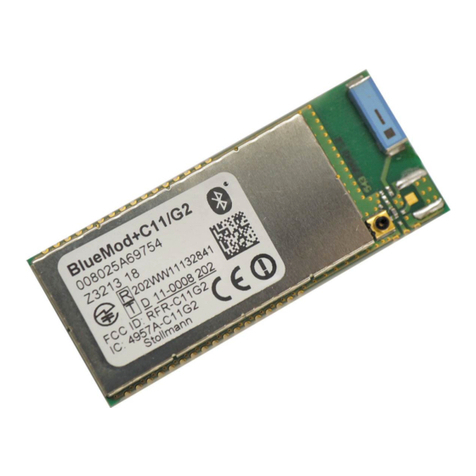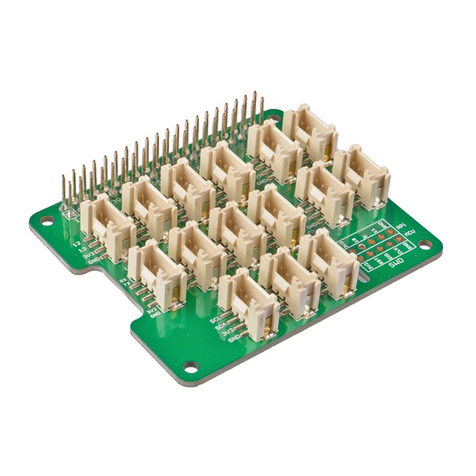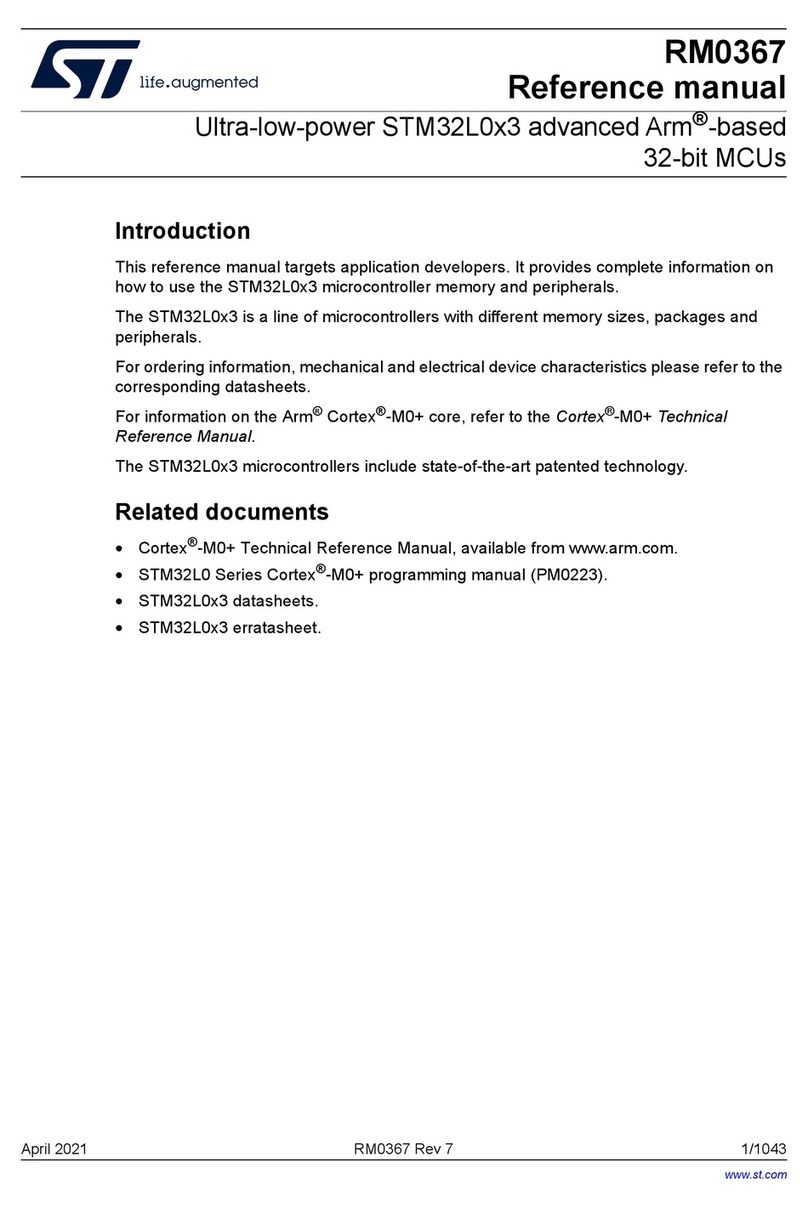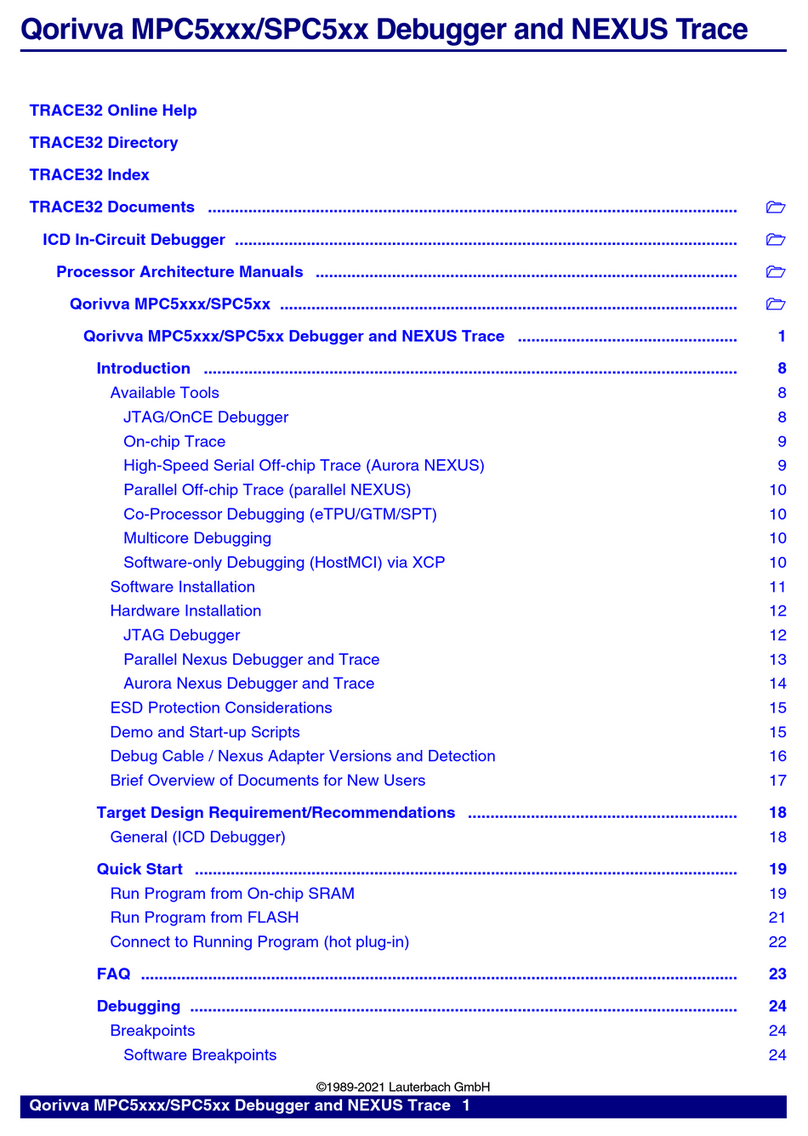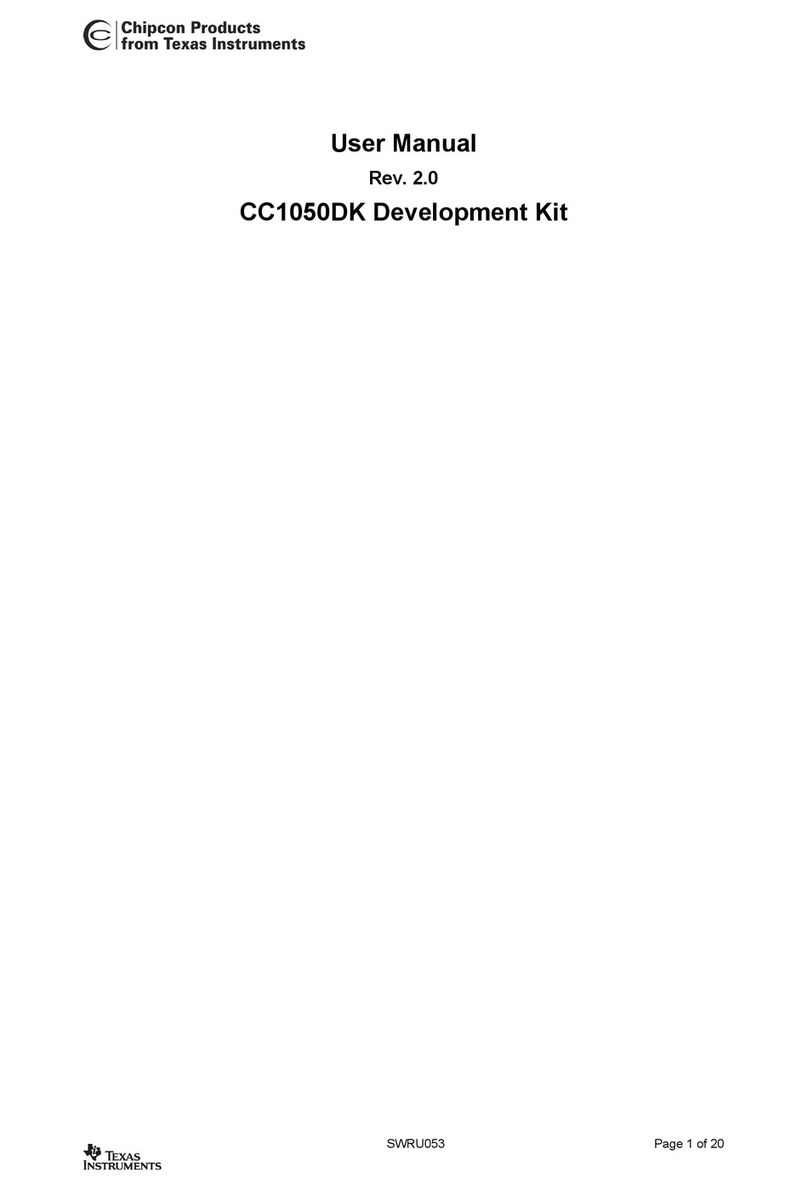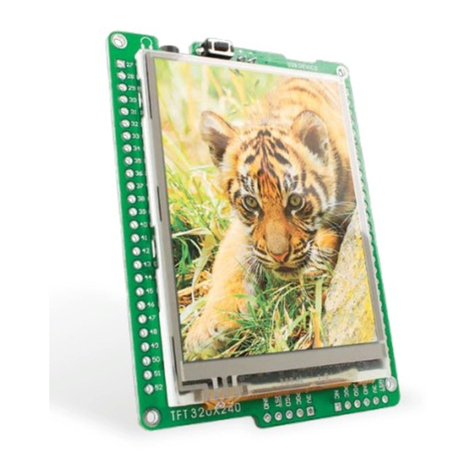Stollmann BlueMod+C11/G2 Series Application guide

BlueMod+C11/G2
Hardware Reference
Release r05

BlueMod+C11/G2
Hardware Reference
Release r05 www.stollmann.de Page 2 of 44
Note
This device was developed for the purpose of communication in an office environ-
ment. It is intended solely for our industrial clients for physical integration into their
own technical products after careful examination by experienced technical personnel
for its suitability for the intended purpose. The device was not developed for or in-
tended for use in any specific customer application. The firmware of the device may
have to be adapted to the specific intended modalities of use or even replaced by
other firmware in order to ensure flawless function in the respective areas of applica-
tion. Performance data (range, power requirements, etc.) may depend on the oper-
ating environment, the area of application, the configuration, and method of control,
as well as on other conditions of use; these may deviate from the technical specifi-
cations, the Design Guide specifications, or other product documentation. The ac-
tual performance characteristics can be determined only by measurements subse-
quent to integration. Variations in the performance data of mass-produced devices
may occur due to individual differences between such devices. Device samples
were tested in a reference environment for compliance with the legal requirements
applicable to the reference environment. No representation is made regarding the
compliance with legal, regulatory, or other requirements in other environments. No
representation can be made and no warranty can be assumed regarding the suit-
ability of the device for a specific purpose as defined by our customers. Stollmann
reserves the right to make changes to the hardware or firmware or to the specifica-
tions without prior notice or to replace the device with a successor model. Of course,
any changes to the hardware or firmware of any devices for which we have entered
into a supply agreement with our customers will be made only if, and only to the
extent that, such changes can reasonably be expected to be acceptable to our cus-
tomers. No general commitment will be made regarding periods of availability; these
must be subject to individual agreement. All agreements are subject to our Terms
and Conditions for Deliveries and Payments, a copy of which is available from
Stollmann.
Copyright © 2005-2009 Stollmann E+V GmbH
Trademarks
The Bluetooth
®
word mark and logos are owned by the Bluetooth SIG, Inc. and any
use of such marks by Stollmann E+V GmbH is under license. Other trademarks and
trade names are those of their respective owners.

BlueMod+C11/G2
Hardware Reference
Release r05 www.stollmann.de Page 3 of 44
Table of contents
1
Introduction........................................................................................................6
1.1
Feature Summary.........................................................................................6
1.2
Applications ..................................................................................................7
2
Block Diagram ...................................................................................................8
3
Application Interface..........................................................................................9
3.1
Power Supply................................................................................................9
3.2
Power-up slew-rate.....................................................................................10
3.3
Power-On-Reset.........................................................................................10
3.4
Serial Interface............................................................................................11
3.4.1
RS-485 Support..................................................................................11
3.5
GPIO Interface............................................................................................13
3.6
Alternate GPIO/IO Functions ......................................................................13
3.6.1
Master/Slave SPI Interface..................................................................13
3.6.2
Synchronous Serial Interface..............................................................14
3.6.3
Multi Channel PWM Controller............................................................14
3.6.4
PCM interface.....................................................................................15
3.6.5
Analog to Digital Converter .................................................................15
3.7
Bluetooth radio Interface.............................................................................16
3.8
Etc..............................................................................................................16
4
Pin Description.................................................................................................17
4.1
Pin Numbering............................................................................................17
4.2
Pin Description............................................................................................18
4.2.1
General Pin Description......................................................................18
4.2.2
Application Specific Pin Description....................................................19
4.2.3
SPP Configuration ..............................................................................19
5
Electrical Characteristics..................................................................................20
5.1
Absolute Maximum Ratings ........................................................................20
5.2
Environmental Requirements......................................................................20
5.3
Operating Conditions..................................................................................21
5.3.1
RF and Supply Connections................................................................21

BlueMod+C11/G2
Hardware Reference
Release r05 www.stollmann.de Page 4 of 44
5.3.2
GPIO, JTAG; Serial IF and Test Pins..................................................22
5.3.3
USB Pins ............................................................................................22
5.4
Power consumption and power down modes..............................................22
5.4.1
SPP configuration...............................................................................23
5.4.1.1
Deep Sleep state..........................................................................23
5.4.1.2
Power down state.........................................................................23
5.4.1.3
Idle state.......................................................................................23
5.4.1.4
Power Consumption.....................................................................23
5.5
RF performance..........................................................................................25
5.5.1
Antenna-Gain and Radiation-Pattern ..................................................27
5.6
Power-up Time ...........................................................................................30
5.7
Wake-up Time ............................................................................................30
6
Mechanical Characteristics..............................................................................31
6.1
Dimensions.................................................................................................31
6.2
Connectors .................................................................................................31
6.3
Recommended Land Pattern......................................................................32
6.4
Soldering Temperature-Time Profile (for lead-free re-flow soldering)..........33
6.5
Housing Guidelines.....................................................................................34
6.6
Antenna Issues...........................................................................................35
6.7
Safety Guidelines........................................................................................37
7
Approvals/Certifications...................................................................................38
7.1
Declaration of conformity ............................................................................38
7.2
FCC Compliance and FCC Statement........................................................39
7.2.1
Caution ...............................................................................................39
7.2.2
FCC Warning......................................................................................39
7.2.3
RF-exposure Statement......................................................................39
7.2.4
Labelling and re-test requirements for the End Product.......................40
7.3
Bluetooth Qualification................................................................................40
7.4
RoHS Declaration.......................................................................................41
8
Related Documents .........................................................................................42
9
Ordering Information........................................................................................42

BlueMod+C11/G2
Hardware Reference
Release r05 www.stollmann.de Page 5 of 44
10
History.............................................................................................................43

BlueMod+C11/G2
Hardware Reference
Release r05 www.stollmann.de Page 6 of 44
1 Introduction
This Hardware Reference Guide documents how BlueMod+C11/G2 can be inte-
grated into customer systems.
It addresses developers of hardware environments for BlueMod+C11/G2.
For detailed information about software interfaces refer to the software reference
manual.
The BlueMod+C11/G2 is available with EDR functionality disabled and enabled. For
the product with EDR disabled all information given in the following chapters regard-
ing EDR performance and functionality is not valid. Information regarding EDR per-
formance and functionality applies only to the BlueMod+C11/G2 with EDR function-
ality enabled.
For the latest version of this document please check the following URL:
http://www.stollmann.de/en/modules/bluetooth-products/bluemod-c11g2/
1.1 Feature Summary
• Bluetooth specification V2.0+EDR
• EDR compliant with V2.0.E.2 of specification for 2Mbps and 3Mbps modulation
modes
• Full Speed Bluetooth Operation with Full Piconet Support
• Scatternet Support
• Complete Co-location and Co-existence with 802.11 (AWMA, AFH and SFH)
• Fast Connection Setup
• RF output power class 1 with power control
• Supply Voltage 3.0V to 3.6V
• Internal crystal oscillator (26 MHz BC04 and 14,7456MHz for ARM7)
• Full Bluetooth data rate up to 2178 kbps asymmetric
• Support for very low-power modes (sleep and deep sleep)
• Full 8- to 128-bit encryption
• High sensitivity design ( -87 dBm typ.)
• Extra ARM7TDMI CPU for embedded profiles and/or application software
• Up to 17 GPIO lines
• USB 2.0 Full Speed Device Interface
• Master/Slave SPI
• Synchronous Serial Controller

BlueMod+C11/G2
Hardware Reference
Release r05 www.stollmann.de Page 7 of 44
• PWM Controller
• PCM Interface
• 10 bit A/D Converter
• Power control
• 5V tolerant I/Os
• -40°C to +85°C industrial operating temperature ran ge
• RoHS Compliant
1.2 Applications
BlueMod+C11/G2 can be used in different applications.
Available applications are
• Bluetooth SPP
• BlueMux Point to Multipoint SPP
• BlueCluster Adhoc Networking
Please refer the software reference and interface specifications for further informa-
tion.

BlueMod+C11/G2
Hardware Reference
Release r05 www.stollmann.de Page 8 of 44
2 Block Diagram
ARM7
CPU
AT91SAM7S
256k
FLASH
64k
SRAM
Bluetooth
BC04-ROM
+3V3
EXT-RES#
RS-232(TTL)
BlueMod+C11/G2
Class1
PA
HCI
SingleChip
+3V3-PA
GPIO
USB2.0 FS
JTAG
TEST
Fig. 1 Block Diagram

BlueMod+C11/G2
Hardware Reference
Release r05 www.stollmann.de Page 9 of 44
3 Application Interface
3.1 Power Supply
The BlueMod+C11/G2 has two power supply rails, which always should be kept on
the same voltage level. Although we recommend using two different power rails, it is
as well possible to feed both rail from a single supply.
Pin # Signal Usage
C-13 3V3 Supply for digital and low power RF circuitry,
C-16 3V3-PA Supply for RF Amplifier
C-14 GND Reference Supply
C-15 GND Reference Supply
The pin order is made such that on the customer hardware directly at the pins of
each supply pair pins (C-13/C14) and pins (C-16/C-15) a 10uF X5R ceramic capaci-
tor with for example a 1206 footprint can be placed for decoupling. It is recom-
mended to add further smaller value ceramic capacitors. These values depend on
noise frequencies on the supply rail. The following picture shows a sample layout
with two linear regulators in SOT23-5 housings and various capacitors in SMT
shapes 0402, 0805 and 1206.
Fig. 2 Sample Layout Power Supply

BlueMod+C11/G2
Hardware Reference
Release r05 www.stollmann.de Page 10 of 44
Each supply rail should be fed with 3,3V, Range 3,0V to 3,6V incl. Noise, low noise
from a linear regulator with fast transient response. Stollmann suggest using two
pcs.
TOREX: XC6204B332MR
regulators, so that the fast current transients of the class1 RF power amplifier do not
interfere with sensitive PLL circuitry of the low power RF circuitry.
For layout guidelines please see sample implementation Stollmann reference design
BlueMod+Eval/C11/G2.
Excessive noise or too slow current transient response on the supply rails may have
an impact on the RF performance.
3.2 Power-up slew-rate
The Power up slew-rate for the BlueMod+C11/G2 must be more then 6V/ms for
proper startup of the AT91SAM7S Controller used on the BlueMod+C11/G2.
Figure 3 shows an example circuit for a power supply. The Output Voltage of the
Regulator is enabled by the Threshold Voltage of a RESET-Circuit, when VCC
Startup ramp reaches a valid Voltage.
Vin
RESET
Enable
Vout
TOREX: XC6204B332MR
VCC 3V3
Vth ~ 2.8 - 3.3V
Figure 3 power supply example circuit
3.3 Power-On-Reset
The BlueMod+C11/G2 is equipped with circuitry for generating Power-On Reset and
to provide under-voltage supervision. An integrated circuit type Maxim DS1818R
provides this functionality.
A reset is generated if the 3.3V supply rail including noise falls below 2,8V to 2,97V.
Via Pin A-1 an external reset can be generated by holding EXT-RES# at ≤0.3V for
≥10ms. A 74LVC14 Schmitt Trigger gate with a 1kR5/10nF low-pass filter at the
input is implemented to avoid false reset pulse recognition due to EMC effects.

BlueMod+C11/G2
Hardware Reference
Release r05 www.stollmann.de Page 11 of 44
If EXT-RES# is not used, it may be left open or tied to VCC.
3.4 Serial Interface
The interface functionally corresponds to the norm V.24 / RS-232 but has TTL-level.
• Transmission speeds 300 bps – 921600 bps (asynchronous)
• Character representation: 7 to 9 Bit, even, odd, mark, space or no Parity, 1, 1.5
or 2 stop bits
• Half duplex or full duplex
• Hardware flow-control (RTS/CTS)
Note: All signals of the serial interface are named according to the EIA232 DTE
definition.
3.4.1 RS-485 Support
For RS-485 support the serial interface has to be connected to an external Trans-
ceiver, we suggest the MAX3491E from Maxim Integrated Products, due to it sup-
ports full duplex transmissions.
UART_RX
UART_TX
BlueMod+C11/G2
Connections in Full Duplex Mode
D
R
RO
RE
DI
DE
GND
A
B
Z
Y
VCC GND
2
3
4
5
14 6,7
9
10
11
12
+
+3,3V
MAX3491E
UART_CTS
GND

BlueMod+C11/G2
Hardware Reference
Release r05 www.stollmann.de Page 12 of 44
CTS
Tbd
b
y
tes
max
Tbd
ns
TXD
RTS
Tbd
character max
Tbd
nS
RXD
Figure 4. UART Timing Diagram
UART_RX
UART_TX
BlueMod+C11/G2
Connections in Half Duplex Mode
D
R
RO
RE
DI
DE
GND
A
B
Z
Y
VCC GND
2
3
4
5
14 6,7
9
10
11
12
+
+3,3V
MAX3491E
UART_CTS

BlueMod+C11/G2
Hardware Reference
Release r05 www.stollmann.de Page 13 of 44
3.5 GPIO Interface
All user signals, except for EXT-RES#, which is routed via an Schmitt Trigger gate,
are connected directly to port pins of the ATMEL AT91SAM7S256 CPU. Except for
USB signals DP, DM and GPIO(4), no additional pull-up or down resistors are im-
plemented, so that the I/O characteristics of the ATMEL CPU apply. These are
• 3V3 logic 5V tolerant
• V
IL
max = 0.8V, V
IH
min = 2.0V, V
IH
max = 5.5V
• V
OH
min = VCC – 0.4V @ I
O
= 8mA, V
OL
< 0.4V @ I
O
= 8mA
• LED’s can be driven directly on specific GPIO lines when I
o
stays below 8mA
All current consumption data in this document are given with I
O
(GPIO) = 0mA
See chapter 5 Electrical Characteristics for detailed information.
• All I/O signals except USB, GPIO(4) and JTAG are connected directly from the
AT91SAM7S pins to the user accessible stamp pins. Therefore, the electrical
characteristics of the I/O pins are programmable in regard to direction, pull-up
resistor, function, push-pull or open drain. Please see specific application soft-
ware documentation for details. After reset, all GPIOs have pull-ups activated.
GPIO10, GPIO8 and TXD have 50kR to 300kR pull-ups, all other I/Os have 5kR
to 20kR pull-ups
3.6 Alternate GPIO/IO Functions
Application specifically dedicated GPIO or IO pins can be programmed to alternative
functionalities. Then pin functionality and direction are fixed for the activated function
block. Many GPIOs are used by the SPP application. See chapter SPP Configura-
tion. Probably some of them can be released for use by other function blocks. Co-
functionality of blocks has to be carefully considered, because pin multiplexing pos-
sibilities are fixed by the ATMEL AT91SAM7S CPU and using a function block often
causes that other function blocks can’t be used at the same time. Please refer to the
ATMEL data sheet AT91SAM7Sxxx Rev. F for complete information. The possibili-
ties depicted in the following chapters are a subset only.
The following function blocks may be usable on the BlueMod+C11/G2:
3.6.1 Master/Slave SPI Interface
DirectionPin # GPIO#
IO Name
Alternative
Signal Name
Description
Master Slave
A5 GPIO1 MISO Master In Slave Out IN OUT
A4 GPIO0 MOSI Master Out Slave In OUT IN
A3 GPIO3 SPCK Serial Clock OUT IN
A6 GPIO2 NPCS0 Peripheral. Chip Select OUT IN
Clock polarity and phase are programmable. The chip select signal is low active.

BlueMod+C11/G2
Hardware Reference
Release r05 www.stollmann.de Page 14 of 44
3.6.2 Synchronous Serial Interface
The Synchronous Serial Interface is capable of handling the protocols I2S, Short
Frame Sync, Long Frame Sync and other Telecom protocols. Receiver and trans-
mitter do act independently. Due to multiplexing interdependencies, the SSC is only
available with the Transmitter clock signal TK used for both directions if the UART IF
is enabled. JTAG reset, signal
/ATRST,
is also not available, if the SSC signal RF,
Receiver Frame Sync is used.
DirectionPin # GPIO#
IO Name
Alternative
Signal Name
Description
Case 1 Case 2
A16 /ATRST RF Receiver Frame Sync IN OUT
A12 GPIO10 RD Receiver Data IN IN
C7 TXD RK Receiver Clock IN OUT
A13 GPIO7 TF Transmitter Frame Sync IN OUT
A11 GPIO8 TD Transmitter Data OUT OUT
A14 GPIO9 TK Transmitter Clock IN OUT
3.6.3 Multi Channel PWM Controller
Each PWM channel can be programmed individually in regard to IO pin assignment
and PWM functionality. Therefore, PWM application designers can choose a proper
channel and pin for their application with the chance not to interfere with other nec-
essary interfaces.
Pin # GPIO#
IO Name
Alternative
Signal Name
Description Direction
A6 GPIO2 PWM0 PWM Waveform Out CH0 OUT
C9 GPIO5 PWM0 PWM Waveform Out CH0 OUT
C5 /CTS PWM1 PWM Waveform Out CH1 OUT
A5 GPIO1 PWM1 PWM Waveform Out CH1 OUT
A5 GPIO1 PWM1 PWM Waveform Out CH1 OUT
C2 GPIO15 PWM1 PWM Waveform Out CH1 OUT
C4 /RTS PWM2 PWM Waveform Out CH2 OUT
A4 GPIO1 PWM2 PWM Waveform Out CH2 OUT
C8 GPIO6 PWM2 PWM Waveform Out CH2 OUT
A3 GPIO3 PWM3 PWM Waveform Out CH3 OUT

BlueMod+C11/G2
Hardware Reference
Release r05 www.stollmann.de Page 15 of 44
3.6.4 PCM interface
Pin # GPIO#
IO Name
Alternative
Signal Name
Description Direction
A12 GPIO10 PCM-OUT PCM Data Out OUT
A11 GPIO8 PCM-IN PCM Data In IN
A14 GPIO9 PCM-CLK PCM Clock OUT ???
A13 GPIO7 PCM-SYNC PCM Frame
Sync OUT ???
PCM-Out has a 10k pull-up to +3V3 and is driven OC only.
The following electrical characteristics apply:
Input Voltage
Levels Min Max
V
IL
- 0.4V +0.8V
V
IH
0.7 VCC VCC +
0.4V
Output Voltage Level
V
OL
(I
O
< 4mA sunk) 0.2V
V
OH
(I
O
< 4mA
sourced) VDD-
0.2V
3.6.5 Analog to Digital Converter
Three ADC channels with 8 to 10bit resolution in reference to 1.8V are available. A
wide range of trigger sources and programmable S&H timing are available.
Pin #
GPIO#
IO Name
Alternative
Signal Name
Description Direction
A16 JTAG-RES# AD3 ADC channel
3 In
analogue
A12 GPIO10 AD0 ADC channel
0 In
analogue
A11 GPIO8 AD1 ADC channel
1 In
analogue

BlueMod+C11/G2
Hardware Reference
Release r05 www.stollmann.de Page 16 of 44
3.7 Bluetooth radio Interface
The BlueMod+C11/G2 offers three population variants for the antenna
1) The BlueMod+C11/G2/AE variant presents a 50Ωimpedance antenna interface
on a Radiall UMP connector, type R107103020. See http://www.radiall.com/
2) The BlueMod+C11/G2/AI variant presents an integrated ceramic antenna.
In both cases the Pins A-26 – A-28 can be left unconnected.
3) The BlueMod+C11/G2/AP variant presents a 50Ωimpedance antenna interface
on pin A-27 with adjacent GND pins A-26 and A-28. In this case Pin A-26 and A28
shall be connected directly to the reference GND plane. Signal routing of the RF
signal on customer PCB has to be implemented with 50R micro-strip line technique.
If the antenna performance does not meet your requirements or you need antenna
support, please contact Stollmann.
3.8 Etc.
For SW development purposes on the module pins a full JTAG interface connected
to the ATMEL CPU is implemented.

BlueMod+C11/G2
Hardware Reference
Release r05 www.stollmann.de Page 17 of 44
4 Pin Description
The BlueMod+C11/G2 module is soldered on customers PCB via stamp pins lo-
cated on the module PCB edges.
4.1 Pin Numbering
Top View

BlueMod+C11/G2
Hardware Reference
Release r05 www.stollmann.de Page 18 of 44
4.2 Pin Description
4.2.1 General Pin Description
Pin Signal Type Ac-
tive
Description
A1 /EXT_RES I-PU L Reset low active internal 47k pull-up
A2 GPIO11 (DTXD) I/O-PU General Purpose IO – Debug Uart Output
A3 GPIO3 () I/O-PU General Purpose IO
A4 GPIO0 () I/O-PU General Purpose IO
A5 GPIO1 () I/O-PU General Purpose IO
A6 GPIO2 () I/O-PU General Purpose IO
A7 ATDO O-PU JTAG test data output
A8 ATCK I-PU JTAG clock
A9 ATMS I-PU JTAG mode select
A10 ATDI I-PU JTAG test data input
A11 GPIO8 (PCM_IN) I/O-PU General Purpose IO
A12 GPIO10 (PCM_OUT) I/O-PU General Purpose IO - internal 10k pull-up
A13 GPIO7 (PCM_SYNC) I/O-PU General Purpose IO
A14 GPIO9 (PCM_CLK) I/O-PU General Purpose IO
A15 GPIO12 (DRXD) I/O-PU General Purpose IO – Debug Uart Input
A16 GPIO16 I/O-PU L General Purpose IO
A17 TST I Test pin – do not connect
A26 ANT_GND
a)
Antenna ground, connect directly to plane
A27 ANT
a)
50 Ohm Rx/Tx connection to antenna
A28 ANT_GND
a)
Antenna ground, connect directly to plane
C1 GPIO14 I/O-PU General Purpose IO
C2 GPIO15 I/O-PU General Purpose IO
C3 GPIO13 I/O-PU General Purpose IO
C4 /RTS I-PU L Request to send
C5 /CTS O L Clear to send
C6 RXD O Receive Data
C7 TXD I-PU Transmit Data
C8 GPIO6 I/O-PU General Purpose IO
C9 GPIO5 I/O-PU General Purpose IO
C10 GPIO4 I/O-PD General Purpose IO - internal 47k pull-down
C11 USB_DM I/O USB D-, Data pin
C12 USB_DP I/O USB D+, Data pin
C13 VCC P +3.3V Power digital and low power RF
C14 GND P GND
C15 GND P GND
C16 VCC P +3.3V Power RF amplifier
Type: PU – pulled up on Module; PD pulled down on Module

BlueMod+C11/G2
Hardware Reference
Release r05 www.stollmann.de Page 19 of 44
Notes:
a) refer to Chapter 3.7
4.2.2 Application Specific Pin Description
4.2.3 SPP Configuration
Pin Pin Name SPP function Type Activ
e Description
A11 GPIO8 Reserved I-PU
A12 GPIO10 Reserved I-PU
A13 GPIO7 /LED1 O L Device ready
A14 GPIO9 /LED2 O L Bluetooth connected. Active if a Bluetooth
connection exists. Inactive in idle state.
Flashes during startup.
C1 GPIO14 /RTC-OUT O L DSR in DCE mode DTR in DTE mode
C2 GPIO15 /DCD I/O-PU L Data Carrier Detect input in DTE mode,
output in DCE mode
C3 GPIO13 /RTC-IN I-PU L DTR in DCE mode DSR in DTE mode
C4 /RTS I-PU L Request to send
C5 /CTS O L Clear to send
C6 RXD O Receive Data
C7 TXD I Transmit Data
C8 GPIO6 /RI I/O-PU Ring Indicator input in DTE mode, output in
DCE mode
C9 GPIO5 Reserved I-PU
C10 GPIO4 DTE-/DCE I-PD 47k
PD DTE DCE mode selector
C13 VCC VCC P +3.3V Power
C14 GND GND P GND
C15 GND GND P GND
C16 VCC VCC P +3.3V Power
A1 /EXT_RES /EXT_RES I L Reset low active
C11 USB_DM Do not connect
C12 USB_DP Do not connect

BlueMod+C11/G2
Hardware Reference
Release r05 www.stollmann.de Page 20 of 44
5 Electrical Characteristics
5.1 Absolute Maximum Ratings
Stresses beyond those listed under “Absolute Maximum Ratings” may cause
permanent damage to the device. These are stress ratings only, and functional
operation of the device at these or any other conditions beyond those indicated
under “Electrical Requirements” is not implied. Exposure to absolute-maximum-
rated conditions for extended periods may affect device reliability.
Item Symbol Absolute Maximum Ratings Unit
Supply voltage V
cc
3,7V with respect to GND to
- 0,4V with respect to GND V
Voltage on any pin V
Pin
VCC + 0,4V with respect to GND to
- 0,4V with respect to GND V
Input RF level P
max
0 dBm
ESD on any pin V
ESD
This device is ESD sensitive. Handling and
assembly of this device should be at ESD
protected workstations.
5.2 Environmental Requirements
Item Symbol Absolute Maximum Ratings Unit
Storage temperature range T
stg
-40 to +105 °C
Operating temperature range T
op
-40 to +85 °C
Other manuals for BlueMod+C11/G2 Series
1
Table of contents
Other Stollmann Microcontroller manuals
Popular Microcontroller manuals by other brands
Freescale Semiconductor
Freescale Semiconductor MPC5604B quick start
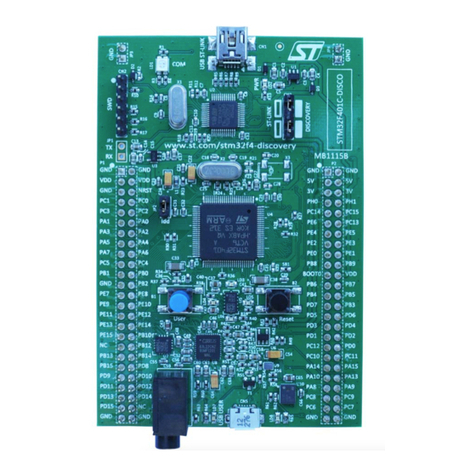
ST
ST STM32F401 Discovery user manual
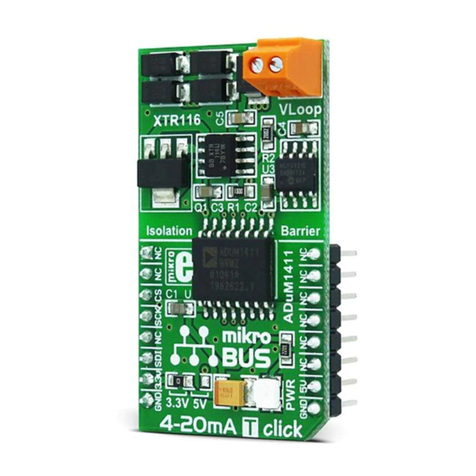
MicroElektronika
MicroElektronika click BOARD 4-20mA T manual

Bosch
Bosch XDK 110 Getting started
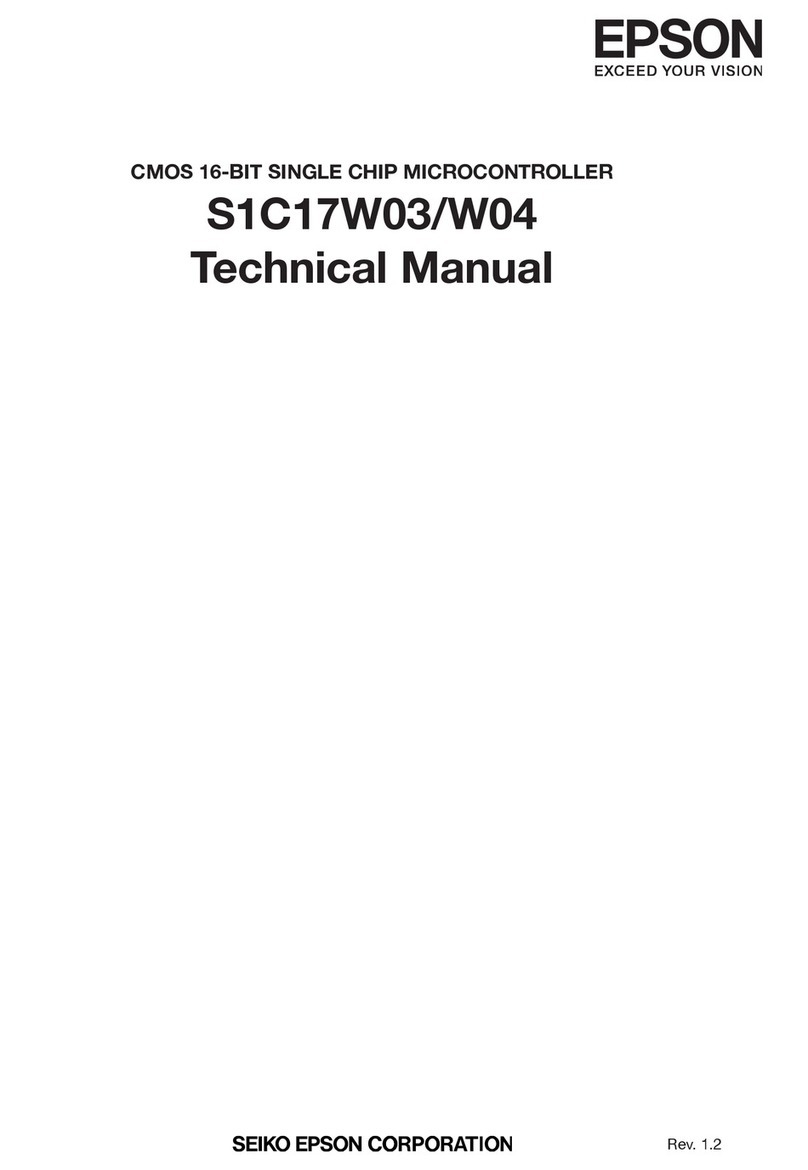
Epson
Epson S1C17W03 Technical manual
Freescale Semiconductor
Freescale Semiconductor TWR-K60N512 quick start guide
